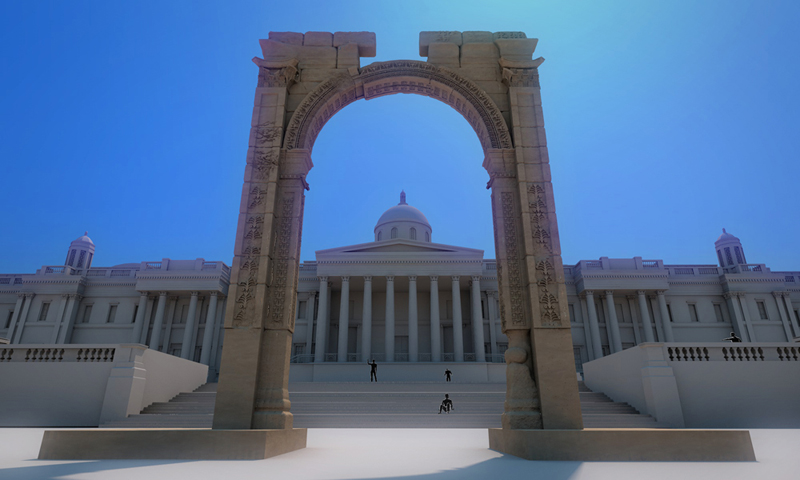Future Histories
What the re-creation of Palmyra's Triumphal Arch in New York and London says about shared cultural identities
What the re-creation of Palmyra's Triumphal Arch in New York and London says about shared cultural identities

Last summer, Daesh militants stormed the ancient Syrian city of Palmyra and murdered its head of antiquities, 82-year-old archaeologist Khaled al-Asaad. UN satellite images show the scope of devastation. All that was left of the 2,000-year-old temple of Bel were itsboundary walls and an arch.
This month, to coincide with World Heritage Week, the Triumphal Arch will be 3D-printed in cement and erected in London’s Trafalgar Square. A duplicate will be displayed concurrently in New York’s Times Square. The installation is a project of the Institute for Digital Archaeology (IDA), a joint venture between Oxford and Harvard universities and the UAE’s Museum of the Future. The IDA augments archaeology, epigraphy and conservation with various scopic technologies – much as forensics are used to authenticate artworks – to analyze, render and preserve artefacts and architecture from the ancient world. An emphasis on crowdsourcing and open-access enhances the database as a kind of universalized, globally shared patrimony. The deployment of 3D printing, meanwhile, lends the project a faintly elegiac air. It’s a technology that produces objects with such speed and disposability that they seem, in some ways, to prefigure their own destruction.
The IDA’s newest project is the open-source Million Image Database, a collaboration with UNESCO and the Museum of the Future (the permanent site for which is scheduled to open in Dubai in December 2018). Some 5,000 3D cameras have been distributed to volunteer photographers who will scan high-resolution footage of at-risk sites and objects in conflict zones around the Middle East and North Africa. Once uploaded, the images will be used to create scale replicas; the 15-metre Palmyra arch is the first such iteration. The project recalls an earlier use of 3D technology to re-create the Bamiyan Buddhas, destroyed by the Taliban in 2001. For a single night in 2015, life-size holographic Buddhas were projected into the cavities where the statues once stood. (The project was a gift to the people of Afghanistan from a Chinese couple.) Similarly, Project Mosul was formed in response to Daesh’s decimation of the Mosul museum artefacts in 2015, but has now extended to digital-heritage reconstruction in post-earthquake Kathmandu.
The much-publicized acquisition policy of Qatar Museums – not so much its accruing of works by Paul Gaugin and Paul Cézanne as its enormous collection of modern and contemporary Arab art – is also relevant here. In particular, its emphasis on building a comprehensive repository of at-risk artwork from Middle Eastern conflict zones – a practice that dates back at least to the 1980s Iran-Iraq war. Less savoury are reports, most recently on the BBC, that many of the artefacts looted from Iraq and Syria in recent decades are now making their way, via London, into the hands of Gulf collectors. Speaking to The New York Times earlier this year, Markus Hilgert, director of the Museum of the Ancient Near East in Berlin, made the observation that: ‘There appears to be an interesting geographic divide: Pre-Islamic objects go to Europe and North America, while Islamic art goes to countries of the Gulf.’ Put crudely, what flows from Iraq and Syria to the Gulf are not simply the displaced peoples of these countries but also their artistic canons and cultural patrimonies. In this, the broad Gulf strategy most closely parallels the Million Image Database’s mantle of guardianship, described on their website as a move to ‘put these crucially important repositories of our cultural identity and shared history forever beyond the reach of those who would destroy them’.
Yet there’s something a bit strange about this invocation of an abstracted, universalized ‘we’ sharing a cultural heritage with ancient Assyria. It has more than a whiff of virtual repatriation, in which high-quality digitized scans of indigenous artefacts are made widely available online while the original objects, which often hold great cultural and spiritual significance, remain in foreign (largely Western) institutions. This reframing feels very much like an extension of the same simplistic narrative that posits the Greeks as the sole founders of Western civilization.
In the context of Gulf states like the UAE and Qatar, this legitimizing impulse is interesting. Despite religious affinities, their neighbours have historically dismissed the Gulf states as isolated tribal backwaters – closer culturally to East Africa, Iran and South Asia than Arabic. On the one hand, the commercial narrative of these states turns, in large part, on an historical rupture, an inversion of those ‘before and after’ satellite images: that, in the beginning, there was an empty desert and coastline scattered with the odd bedouin or pearl diver and then, magically, oil, Doha and Dubai appeared. As these countries begin to flex their political, cultural and financial muscle, however, the scaffolding of a suitably august civilizational genealogy becomes increasingly important. If anything, this reconstruction of heritage and quiet battle for regional cultural stewardship works to write the UAE and Qatar into a global history from which they have long been excluded.


















